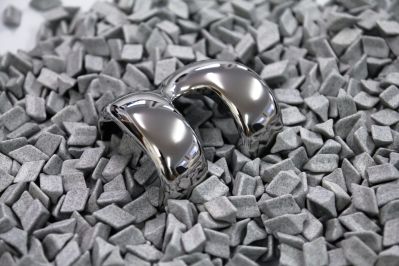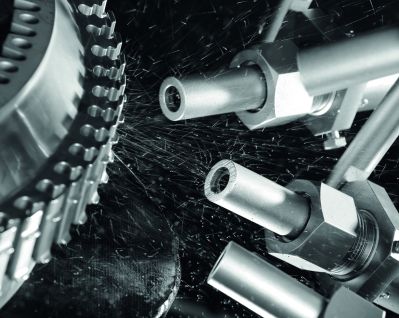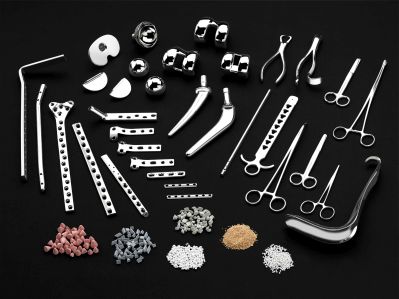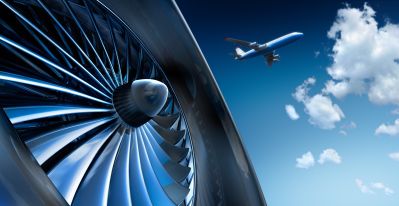Choosing How You Finish
In the precision-driven medical and aerospace industries, the roles of mass finishing and shot blasting technologies cannot be overstated. These processes are instrumental in ensuring both the reliability and safety of critical components. Colin Spellacy, Head of Sales, Rösler UK, examines their impact on product durability and performance, and explains why it's not just about aesthetics when it comes to life-saving medical devices and high-performance aerospace systems.
Mass finishing and shot blasting are two distinct industrial processes used for surface finishing of components, each with its unique method and application.

Rö mass finishing offers more than 1,000 surface finishing options -- the uses for mass finishing machines are almost limitless.
Mass finishing, encompassing techniques like tumbling, vibratory finishing, and centrifugal finishing, involves placing parts in a machine with abrasive media, where they are finished through a combination of mechanical and chemical actions. This method is particularly effective for deburring, smoothing, polishing, and cleaning a large number of small to medium-sized parts simultaneously, making it ideal for intricate components with complex geometries. The gentle and controlled nature of mass finishing ensures uniform treatment of all surfaces, crucial in industries like medical, where precision and consistency are paramount.
Shot blasting, on the other hand, employs the forceful projection of abrasive materials, such as steel or glass beads, against the surface of the component. This high-energy process is excellent for cleaning, strengthening (peening), or roughening surfaces, and is often used for larger, more robust components. Its aggressive nature makes it suitable for removing heavy scale, rust, or old coatings, and it is commonly employed in industries like aerospace and automotive for preparing surfaces for painting or coating.

Shot blasting machines offer you almost unlimited options for surface finishing: from deburring, descaling, de-sanding and rust removal to roughening, cosmetic blasting, smoothing and edge rounding all the way to shot peening.
The choice between mass finishing and shot blasting depends on the specific requirements of the application: mass finishing is preferred for delicate, precision parts requiring uniform treatment, while shot blasting is chosen for its aggressiveness and suitability for larger, tougher components needing thorough surface preparation.
Mass Finishing and Shot Blasting in Medical and Aerospace Applications
In the medical industry, mass finishing, prior to final sterilization in accordance with applicable medical regulations, is essential for ensuring the safety and effectiveness of various devices. The process is widely used to smooth and polish implantable devices, surgical instruments, and other medical tools.
The primary objective is to eliminate any surface irregularities that could harbor bacteria or cause patient discomfort. For instance, mass finishing is vital in the production of orthopaedic implants, where a smooth surface can significantly reduce the risk of tissue irritation and promote better integration with the body. Additionally, the process is used to clean and finish components of diagnostic equipment, ensuring that they are free of contaminants and safe for patient contact.

In the medical and aerospace industries, where even minor flaws or inconsistencies can have significant consequences, high quality and reliability in finishing equipment is a necessity.
Shot blasting, in the context of the aerospace industry, is crucial for preparing component surfaces for further processing and ensuring their structural integrity. This process is extensively used for cleaning, texturizing, or peening surfaces of aircraft components made of metals and alloys. By removing surface contaminants, shot blasting enhances the adhesion properties of subsequent coatings, which is critical for parts that are exposed to extreme environmental conditions. Moreover, shot blasting is employed for stress-relieving and strengthening components through peening, a process that improves fatigue resistance and prolongs the lifespan of critical aerospace parts such as turbine blades, landing gear, and fuselage components.
How to Select a Finishing Supplier
To excel in providing top-tier mass finishing and shot blasting technologies, a company must possess a blend of advanced technical capabilities, extensive industry knowledge, and a commitment to innovation. At its core, the company should be equipped with state-of-the-art machinery and technology capable of handling a diverse range of materials and component geometries.

Rösler focuses on automated and turnkey solutions to fill the needs of modern manufacturing, especially in high-tech sectors such as aerospace.
In addition to technical prowess, the ideal company should have a strong customer-centric profile, marked by a deep understanding of various industry requirements and a tailored approach to each project. This means not just selling equipment, but partnering with customers to understand their specific needs, whether they are in the aerospace, medical, or any other sector with stringent finishing standards.
By combining cutting-edge technology with personalized, industry-specific service, a company can truly deliver the best in mass finishing and shot blasting technologies, becoming a trusted ally in their clients' pursuit of excellence.
This customer-focused approach should be backed by a strong commitment to quality and safety, ensuring compliance with international standards and regulations. A provider excelling in these technologies would also prioritize sustainability, continually seeking ways to minimize environmental impact, such as by developing eco-friendly media and optimizing energy efficiency in their machines.
Ultimately, the hallmark of a leading company in this field is its ability to merge technical expertise with a responsive and responsible service ethos, setting the standard for innovation, reliability, and customer satisfaction in the realm of mass finishing and shot blasting technologies.
Want more information? Click below.
Rate this article
View our terms of use and privacy policy ::m::